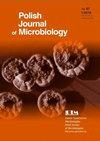Vaginal Secretion Epithelium Count As a Prognostic Indicator of High Abundance of Ureaplasmas in Women with a Normal Nugent Score
IF 1.6
4区 生物学
Q4 MICROBIOLOGY
引用次数: 0
Abstract
Abstract Genital tract ureaplasma infections are associated with numerous complications, ranging from inflammation, through infertility, to problematic pregnancy. In the course of ureaplasma infection, the risk of human papillomavirus infection increases. Diagnostic tests for urea-plasma infections are not always carried out, especially in women with the normal Nugent test results. The study attempts to check whether it is possible to find a prognostic indicator that could suggest a high abundance of ureaplasmas (≥ 104 CFU/ml) at the stage of the initial examination of vaginal discharge. Such a prognostic factor could qualify women for further tests to detect infections with these atypical bacteria. Six hundred twenty-seven white women with a score of 0–3 on the Nugent scale were tested, including 322 patients with a high abundance of ureaplasmas (≥ 104 CFU/ml) and 305 who tested negative for these bacteria. Ureaplasma infections were detected statistically significant in women who had few or no epithelial cells in the genital swab specimens compared to the results obtained for women with numerous or very numerous epithelial cells (p < 0.001). The risk of the high density of ureaplasmas was 38.7% higher with fewer or no epithelial cells than with high numbers. In patients aged 18–40 years with few or no epithelial cells, a high density of ureaplasmas (≥ 104 CFU/ml) was observed significantly more frequently (p = 0.003). Determining the number of epithelial cells in Gram-stained slides may be the prognostic indicator of ureaplasma infection. Testing for genital ureaplasma infection should be considered, especially in women of childbearing age (18–40 years), even if the Nugent test value is normal and pH ≤ 4.6.阴道分泌物上皮计数是Nugent评分正常的女性高解脲原体丰度的预后指标
摘要生殖道脲原体感染与许多并发症有关,从炎症到不孕不育,再到问题妊娠。在脲原体感染过程中,人乳头瘤病毒感染的风险增加。尿素血浆感染的诊断测试并不总是进行的,尤其是在Nugent测试结果正常的女性中。该研究试图检查是否有可能找到一个预后指标,该指标可能表明在阴道分泌物的初步检查阶段存在高丰度的脲原体(≥104CFU/ml)。这样的预后因素可能使女性有资格接受进一步的检测,以检测这些非典型细菌的感染。对627名Nugent量表得分为0-3的白人女性进行了检测,其中322名患者的脲原体丰度较高(≥104 CFU/ml),305名患者的这些细菌检测呈阴性。生殖拭子标本中上皮细胞很少或没有上皮细胞的女性与上皮细胞数量众多或非常多的女性相比,检测到的支原体感染具有统计学意义(p<0.001)。上皮细胞较少或没有上皮的女性患高密度脲原体的风险比上皮细胞数量较多的女性高38.7%。在18-40岁且上皮细胞很少或没有上皮细胞的患者中,观察到高密度脲原体(≥104CFU/ml)的频率明显更高(p=0.003)。测定革兰氏染色玻片中上皮细胞的数量可能是脲原体感染的预后指标。即使Nugent检测值正常且pH≤4.6,也应考虑生殖器脲原体感染检测,尤其是育龄妇女(18-40岁)。
本文章由计算机程序翻译,如有差异,请以英文原文为准。
求助全文
约1分钟内获得全文
求助全文
来源期刊

Polish Journal of Microbiology
MICROBIOLOGY-
CiteScore
3.70
自引率
4.80%
发文量
41
审稿时长
2 months
期刊介绍:
Polish Journal of Microbiology (PJM) publishes original research articles describing various aspects of basic and applied microbiological research. We are especially interested in articles regarding
- basic biological properties of bacteria and archaea, viruses, and simple
- eukaryotic microorganisms
- genetics and molecular biology
- microbial ecology
- medical bacteriology and public health
- food microbiology
- industrial microbiology
- bacterial biotechnology
 求助内容:
求助内容: 应助结果提醒方式:
应助结果提醒方式:


